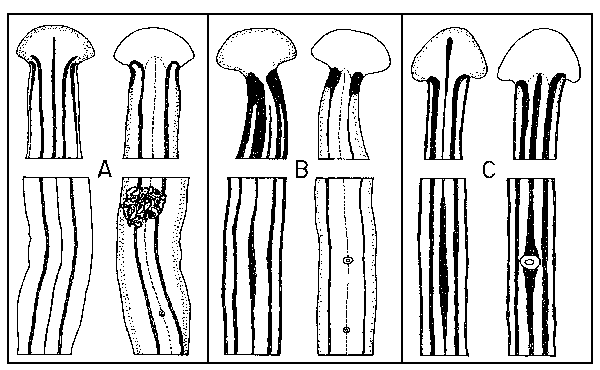
Contact: (Sasaki) gen-yu@mtc.biglobe.ne.jp (Kawakatsu) DQA01524@nifty.ne.jp
Last update: 18-OCT-2001http://www.ct.sakura.ne.jp/~gen-yu/lp/shibukitsubo/lp.html
The SHIBUKITSUBO (Bulletin of the Niigata Shell Club; ISSN 0917-7159) is a local publication issued annually from the Niigata Shell Club (Honorary President: H. Murayama). The name of the magazine was taken from the Japanese generic name of rare land snails: Fukuia Abbott et Hunter, 1949 (Super fam. Rissoidea, fam. Amonicolidae).
During the past 4 years (1998-2001), 5 articles on land planarians were published in the SHIBUKITSUBO (Nos. 19-22): 4 articles in Japanese (with English abstracts) and a single English article (with a Japanese abstract). The SHIBUKITSUBO is not found in libraries of foreign countries. Thus, we considered that the compilation of English Electronic Versions of the combined abstracts and text of 5 articles mentioned above was desirable. We also added some reduced figures taken from the original papers.
The compilers are indebted to the members of the Editorial Board of the SHIBUKITSUBO for the permission of the opening of this web article. They are also indebted to the previous coauthors of the original 5 articles issued in the SHIBUKITSUBO: Mr. Atsushi Koike (Numata, Japan), Mr. Kiyohiko Yamamoto (Nagasaki, Japan), Mr. Noboru Yoneyama (Kashiwazaki, Japan), Dr. Alexei V. Chernyshev (Vladivostok, Russia), Dr. Robert E. Ogren (Kingston, PA, U.S.A.) and Dr. Eudoxia M. Froehlich (São Paulo, Brazil). Dr. Ogren is thanked for his kind reading of this draft.
A single specimen of a black-colored land planarian species was obtained at Numata City, on May 25, 1997. The length (TL) and width (WM) of a live specimen are as follows: TL, 130mm; WM, 5-8mm. The animal kept in a terrarium was fed a snail (Euhadra quaesita); a normal feeding was observed. However, 4 days later, the planarian died and its body had disintegrated.
Additional Note by M. Kawakatsu: So-called "Bipalium fuscatum" in Japan may consist of 2 species, i.e., Bipalium fuscatum Stimpson, 1857 (type locality, Shimoda in the Izu Peninsula) and another new species (cf. Kawakatsu, 1991. Bull. Biogeogr. Soc. Japan, 46: 39-52). Moreover, the distribution records of "B. fuscatum" in India and Indonesia (von Graff, 1899) are due to misidentification of samples. The taxonomic problem will be discussed by Kawakatsu & Ogren in the OECD Workshop on Terrestrial Planarians (Christchurch, New Zealand: Feb. 16-20, 1998)*1.
*1. Notice by Kawakatsu. The following paper was published. Kawakatsu, M., Ogren, R. E. & Froehlich, E. M., 1998. The taxonomic revision of several homonyms in the genus Bipalium, family Bipaliidae (Turbellaria, Seriata, Tricladida, Terricola). Bull. Fuji Women's College, (36), II: 83-93.
The genus Novibipalium Kawakatsu, Ogren et Froehlich, 1998, was established in this paper. Thus, a Japanese black, middle-sized, bipaliid species known as "Bipalium fuscatum", or "Placocephalus fuscatus", is separated into 2 species, i.e., Bipalium fuscatum Stimpson, 1857, and Novibipalium falsifuscatum Kawakatsu, Ogren et Froehlich, 1998. The male genital anatomy of the latter is very different from that of the former in having a highly muscular male antrum wall.
Bipalium nobile Kawakatsu et Makino, 1982, is a giant, non-native species described from Tôkyô (Fig. 1 A). First discovered in 1968 it has subsequently been found in many localities of Japan.

Fig. 1. Comparison of general external characters of Bipalium nobile Kawakatsu et Makino, 1982 (A), Bipalium kewense Moseley, 1878 (B), and Bipalium multilineatum Makino et Shirakawa, 1983 (C). For each species, 4 figures are given: both dorsal (left side) and ventral (right side) views are shown; the upper row indicates the head and the lower row, the pharynx-copulatory apparatus region.
The last distribution records are shown in Fig. 2. In Japan, 2 additional bipaliid species with 3 or 5 longitudinal lines on the dorsal side of the body (and with 2 or 3 longitudinal lines on the ventral side) are known. One of them is Bipalium kewense Moseley, 1878 (Fig. 1 B). This cosmopolitan species is now recorded in the vicinity of Tôkyô, Chichijima Island (the Ogasawara Islands) and Okinawa Island (the Southwest Islands of Japan); it is also found in 2 localities at Nagasaki in Kyûshû. This species may have a naturalized population in Japan. Another probably native species, Bipalium multilineatum Makino et Shirasawa, 1983, described by non-sexual animal from Tôkyô (Fig. 1 C), is known only from in the vicinity of Tôkyô (including Chiba and Saitama Prefs. in the Kantô Region in Honshû).
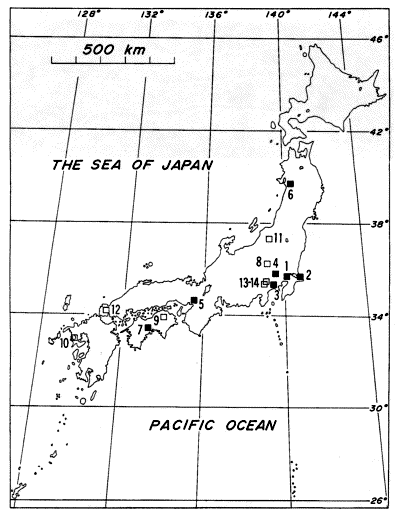 |
Fig. 2. Map showing the distribution records of Bipalium nobile in Japan. |
Nîgata Prefecture in Honshû, Japan, is a new locality for a giant species of land planarian, Bipalium nobile Kawakatsu et Makino, 1982, first recorded in 1997 from Sanjô City (cf. Kawakatsu, Murayama, Yamamoto & Yoneyama, 1998). In the summer of 1998, many specimens of B. nobile were discovered at Ojiya City. After this local news item appeared, Murayama (who visited the Ojiya locality with the science reporter, Mr. K. Ebisu) received telephone messages from 69 subscribers about new localities of this very large, elongate bipaliid species. These telephone reports, including several photographs and worms sent to Murayama, represent two species:1) Bipalium nobile (![]() living animals over 30 cm in length) and 2) Bipalium spp. (
living animals over 30 cm in length) and 2) Bipalium spp. ( living animals less than 30 cm in length). The latter may include young specimens of B. nobile (?) and specimens of Bipalium multilineatum Makino et Shirasawa, 1983. Although B. multilineatum is known from Tôkyô and its vicinity, Murayama's non-sexual samples from Ryôtsu City in Sadogashima Island, Nîgata Pref. examined by Kawakatsu, appear to be the same species. Additionally, this species was recently found at Shirahama, Wakayama Prefecture in Honshû and Nagasaki in Kyûshû, Japan (Kawakatsu's unpublished data)*2.
The distribution localities of two bipaliid species in Nîgata Prefecture shown in Fig. 3 are coincident with newly-rising dormitory towns developed after World War II. These bipaliid species may have expanded their domains as the result of commercial distribution of potted garden plants.
living animals less than 30 cm in length). The latter may include young specimens of B. nobile (?) and specimens of Bipalium multilineatum Makino et Shirasawa, 1983. Although B. multilineatum is known from Tôkyô and its vicinity, Murayama's non-sexual samples from Ryôtsu City in Sadogashima Island, Nîgata Pref. examined by Kawakatsu, appear to be the same species. Additionally, this species was recently found at Shirahama, Wakayama Prefecture in Honshû and Nagasaki in Kyûshû, Japan (Kawakatsu's unpublished data)*2.
The distribution localities of two bipaliid species in Nîgata Prefecture shown in Fig. 3 are coincident with newly-rising dormitory towns developed after World War II. These bipaliid species may have expanded their domains as the result of commercial distribution of potted garden plants.
*2. Notice by Kawakatsu. The following papers were published.
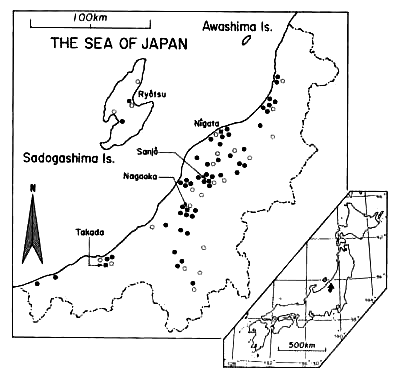 |
Fig. 3. Map showing the distribution records of bipaliid species in Nîgata Pref., Chûbu Region, Honshû, Japan. |
On May 26 of 1987, Chernyshev found a land planarian in a garden of his residence located in the suburbs of Vladivostok, Russia (lat.43°07´N and long.131°54´E). According to his observation, a live specimen was found on a stony slope with shrubs. In the creeping state, it measured approximately 35 mm in length and 3 mm in width. The head has a semilunar shape, with short, non-recurved auricles. The dorsal surface of the body of the live specimen was whity-brown with a narrow, longitudinal, median stripe of a dark-brown coloration; the ventral surface is a pale coloration. When the animal was fixed with 3% formalin solution by Chernyshev, it was strongly contracted and formed a ring in appearance (Fig. 4 A and B).
The preserved sample received by Kawakatsu in August of 1998 was very hardened; a crack was found at the posterior level of the body (Fig. 4 A and B; KSL No. 2311). This sample was kept in a solution of glycerin-alcohol for about one year duration. Then, a slightly softened sample was cut transversally into 3 pieces (the head piece, prepharyngeal-pharyngeal piece and tail piece) as shown in Fig. 4 C-E ( a dorsal view) and F-H (a ventral view).
In the preserved specimen examined by Kawakatsu, the dorsal surface of the body is uniformly pale gray to slightly greenish gray (the middorsal stripe was disappeared in the sample in formalin solution); the ventral surface is a pale coloration with a moderately wide creeping sole (Fig. 4 F-H).
The measurement data of the preserved sample are as follows: TL (total length), 20 mm; HML (distance from the anterior tip to the mouth), 16.2 mm; WM (width over the mouth), 4.8 mm; TB (thickness of the body at the level just anterior to the pharyngeal region), 2 mm. Many small eyes are arranged along the entire margin of the head (they are not clear in the photograph of Fig. 4 C).
|
Fig. 4. Photographs of Bipaliidae sp. from Vladivostok (KSL No. 2311). A and B: side views of a preserved specimen; C-E: dorsal view of the specimen after transverse cutting into 3 pieces; F-H: ventral view of the 3 pieces. Notice the creeping sole. A part of pharynx is seen on the anterior cut-surface of the tail piece (H). An arrow indicates the level of mouth opening (a crack occurred here). White scales, 1mm. |
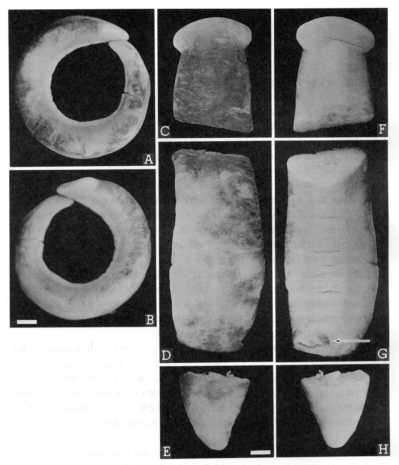 |
The species identification of this non-sexual bipaliid land planarian from Vladivostok is impossible. Since the family Bipaliidae Stimpson, 1857, consists of two genera based upon the differences of the genital anatomy of animals (Bipalium Stimpson, 1857, and Novibipalium Kawakatsu, Ogren et Froehlich, 1998), the confirmation of the genus of the Vladivostok sample is also impossible. Thus, the animal is recorded as Bipaliidae sp. This is the first record of occurrence of bipaliids from Russia (cf. Ogren, Kawakatsu & Froehlich, 1987, 1988). The preserved sample in 70% ethanol is tentatively retained in Kawakatsu's Collection (Sapporo).
Kawakatsu, M., Ogren, R. E., Froehlich, E. M. & Murayama, H., 2001. On the Places of Origin of Three, Very Large Bipaliid Land Planarians from Japan (Turbellaria, Seriata, Tricladida, Terricola). Shibukitsubo, No. 22: 39-52. (In English, with Japanese abstract.)*3 |
There are in Japan several species of land planarians having a semilunar head characteristic of the family Bipaliidae Stimpson, 1857. Three of these are particularly well known because of their large size and regular occurrence in recent years. Among these three bipaliids, Bipalium nobile Kawakatsu et Makino, 1982, and Bipalium kewense Moseley, 1878, seem to be non-native species. Bipalium multilineatum Makino et Shirasawa, 1983, seems to be a native species. They typically have 3 or 5 longitudinal dorsal stripes and 2 or 5 stripes ventrally.
The first of these species is Bipalium nobile Kawakatsu et Makino, 1982. It was first discovered in a garden of the Imperial Palace of Tôkyô in 1968. It has subsequently been discovered in many other localities of Japan during the past 40 years (Honshû, Shikoku and Kyûshû; see Kawakatsu, Murayama, Yamamoto & Yoneyama, 1998; Kawakatsu, Yamamoto, Ogren & Takai, 2000; Murayama & Kawakatsu, 1999; Nunomura, 2000; Yamamoto, Takai, Ogren & Kawakatsu, 2000). B. nobile is the largest bipaliid species of land planarians in the world. In locomotion, a live specimen may measure over 1,000 mm in length. The usual length is 300-800 mm and 5-10 mm wide.
*3. Notice by Kawakatsu. Since this paper was submitted for publication, an old Chinese Ms. (produced in 739) including a note on bipaliid species has recently come to Kawakatsu's attention. See the following articles in the "Gen-yu's Files".
Bipaliid land planarians recorded in Chinese and Japanese Materia Medica (English Version).
http://www2u.biglobe.ne.jp/~gen-yu/kougai_e.html
The Japanese Version is also available.
http://www2u.biglobe.ne.jp/~gen-yu/kougai.html
Additional morphological characters are: head semicircular and dark brown to blackish brown in color with a pale, narrow edge; dorsal surface uniformly yellowish brown in color with 3 longitudinal, blackish brown stripes extending the body length, of which the middle one, extends onto the head plate, is narrower and darker than the lateral stripes, and a pair of short marginal stripes in the anterior portion of the prepharyngeal region; ventral surface faintly pale yellowish brown in color with broad, indistinct, dark longitudinal stripes on each border of the creeping sole (cf. Kawakatsu, Makino & Shirasawa, 1982; see Fig. 1 A).
The second species is Bipalium kewense Moseley, 1878. This cosmopolitan species is now recorded in the vicinity of Tôkyô, Chichijima Island and Hahajima Island (the Ogasawara Islands), Nagasaki and its vicinities in Kyûshû, and Okinawa Island (cf. Kawakatsu, Murayama, Yamamoto & Yoneyama, 1998; Kawakatsu, Okochi, Sato, Ohbayashi, Kitagawa & Totani, 1999; Kawakatsu, Yamamoto, Ogren & Takai, 2000; Murayama & Kawakatsu, 1999; Yamamoto, Takai, Ogren & Kawakatsu, 2000). The species is recently recorded from Tanabe City, Wakayama Prefecture, Kinki Region in Honshû (cf. Kubota, Yamamoto & Kawakatsu, 2001).
B. kewense is smaller in size than B. nobile(60-350 mm long and 3-5 mm wide). Additional morphological characters are: head lunate or semicircular and dark brown to blackish brown in color; dorsal surface yellowish brown in color. The mid-dorsal stripe begins at the base of the head plate, being widest in the region of the pharynx and copulatory organs. On either side of the neck region, there is a broad, dark pigmented patch slightly elongated and shield-shaped, extending ventrally as an open collar, that gives rise to lateral and marginal stripes; lateral stripes closer to the midline, often broader than the other stripes and extend to the posterior where they may join; marginal stripes along the edge of the body are narrow extending nearly the entire length of the body. Ventrally, the surface is grayish white;the medial, slightly humped, creeping sole is bordered by narrow, light-pigmented longitudinal stripes that begin in the pigmented neck region (cf. Kawakatsu, Makino & Shirasawa, 1982; Winsor, 1983; see Fig. 1 B).
Note. Yamada (1971) observed a live specimen of a very long bipaliid animal in Nepal (over 40 cm in length;the sample was lost) (cf. Kawakatsu, 1997: 50; Ogren, Kawakatsu & Froehlich, 1997; 56, Bipalium sp. of Nepal). There is some possibilities that the species is B. kewense.
The third species is Bipalium multilineatum Makino et Shirasawa, 1983. It was described from the vicinity of Tôkyô based on non-sexual specimens and because of this it cannot be assigned to a new genus based on copulatory organs.
Note. The taxonomic revision of the Bipaliidae is now in progress on the basis of the genital anatomy. Up to the present, three genera are recognized in it (cf. Kawakatsu, Ogren & Froehlich, 1998; Ogren & Sluys, 1998, 2000).
B. multilineatum is smaller than B. nobile (60-300 mm long and 5-7 mm wide). Morphological characters are: head semicircular with bluntly pointed auricles, in dusky brown color; dorsal surface yellowish to greenish brown; mid-dorsal stripe begins at anterior part of the head plate (the anterior portion forms a club-shaped enlargement); paired lateral stripes are wide; paired marginal stripes are thinner and extend the entire body length; ventral paler than the dorsal surface; 5 longitudinal ventral stripes (a wide, mid-dorsal one with widened portion at the pharyngeal region surrounding the mouth opening, a pair of rather wide lateral stripes, and a pair of thin marginal ones). (Cf. Makino & Shirasawa, 1983; see also Kawakatsu, Murayama, Yamamoto & Yoneyama, 1998; Kawakatsu, Yamamoto, Ogren & Takai, 2000; Yamamoto, Takai, Ogren & Kawakatsu, 2000; see Fig. 1 C.) The species has been recently recorded from Tanabe City and its vicinity, Wakayama Prefecture, Kinki Region in Honshû (cf. Kubota, Yamamoto & Kawakatsu, 2001).
In 1922 Kaburaki published two taxonomic papers on Japanese land planarians (including species from Taiwan). Descriptions and records of 15 bipaliid species were given in his old-fashioned papers (original descriptions of 10 new species and redescriptions of 5 species) (cf. Kawakatsu, 1983, 1991). Among these bipaliids, the species having 3 to 5 dorsal stripes are the following: Bipalium trifuscostriatum Kaburaki, 1922, from Sakata and Ôtsu, near Kyôto in Honshû, and Bipalium trilineatum Stimpson, 1857, from Hakodate in Hokkaidô (type locality), Kumamoto in Kyûshû, and Taiwan. The third species, “Placocephalus virgatus”, from Taiwan will be mentioned in the next section.
Although B. trifuscostriatum was originally described from specimens that were not fully sexually matured, it was redescribed by Kawakatsu (1991) from a modern taxonomic viewpoint. This moderately large (over 85 mm long and 6-8 mm wide in life), dull brown species has 3 longitudinal stripes on the dorsal surface (a single, rather narrow, clear, middorsal one and a pair of broad, less definite lateral ones) and without ventral stripes (cf. Kawakatsu, 1991).
The name of B. trilineatum was frequently mentioned in many Japanese zoology books and illustrated encyclopedias until recently. However, Stimpson's “B. trilineatum” cannot be identified at present from his description alone. Therefore, it is recommended to avoid confusion that the name of this species inquirenda should not be applied to new specimens from the type locality under study. Although external morphology is known, there is no knowledge of internal anatomy and copulatory organs for comparisons (cf. Kawakatsu, Makino & Shirasawa, 1982: 256-257; Ogren & Kawakatsu, 1987: 104-105).
In his description of “B. trilineatum” from Kumamoto in Kyûshû, Kaburaki (1922a: 33) wrote as follows:
“The dorsal surface in the living state is of a dirty yellowish orange colour with three well-developed [well-defined] black stripes, which extend almost throughout the whole length of the body. The median stripe extends to a point on the head and loses itself gradually in the general colour of the head, which is much lighter than that of the trunk. Ventrally, the colour is similar to that of the dorsal side, though usually paler, except for the surface of the sole which is nearly white.”
Judging from the painting of an animal in color (Kaburaki, loc. cit., pl. I, fig. 16), the middorsal stripe starts from nearly the middle part of the head plate. His largest specimen examined was 54 mm long by 4 mm broad.
The land planarian samples used by the late Dr. Kaburaki were collected partly by himself, and partly by the late Dr. I. Ijima and their colleagues in the 1910s' to 1920s'. And, they were residents of Tôkyô at that time. It is a very interesting fact that no descriptions about the 3 large-sized bipaliid species (B. nobile, B. kewense and B. multilineatum)… or some notes assigned to them … are found in Kaburaki's (1922a, b) papers. Uudoubtedly, B. nobile and B. kewense are very noticeable species; it is, therefore, logical to expect, if these species were present in Tôkyô during Kaburaki's professional life, they would have been noticed and collected.
We consider B. nobile and B. kewense to be exotic not indigenous species of Japan. The former may have been introduced during the late 1950s' into the vicinity of Tôkyô from some SE Asian countries; it may have expanded its domain as the result of commercial distribution of potted garden plants (cf. Kawakatsu, Murayama,Yamamoto & Yoneyama, 1998; Murayama & Kawakatsu, 1999).
Judging from the present distribution range of B. kewense in Japan (the Ogasawara Islands, Okinawa Island in the Southwest Islands of Japan, etc.), this exotic cosmopolitan species may have been introduced into Japan after World War II from some Pacific islands with plant materials. The distribution pattern of B. kewense in the Ogasawara and Okinawa is very similar to that of the other exotic, rhynchodemid species Platydemus manokwari de Beauchamp, 1962, that was recently introduced into these islands. The source of the Ogasawara populations of B. kewense may have been plants and soil transplanted from Okinawa, as in the case of Pl. manokwari (cf. Kawakatsu, Okochi, Sato, Ohbayashi, Kitagawa & Totani, 1999).
Animals of B. multilineatum are usually smaller than those of B. nobile and B. kewense. Although no record of animals assigned to B. multilineatum is found in Kaburaki's papers (1922a, b), it has been suggested that this species may be native in Japan (cf. Kawakatsu, Murayama, Yamamoto & Yoneyama, 1998; Murayama & Kawakatsu, 2000).
Note. One has to admit that all land planarians of the Japanese Islands are to be considered exotic, since they did not evolve there. The Indo-Malay region has numerous tropical species of the Bipaliidae (cf. Hyman, 1951; Ogren, Kawakatsu & Froehlich, 1997, 1998). The proto-species of the bipaliids in this geographical area probably invaded the Old Japanese Islands from the southeastern route via the Old Asian Continent. Thus, the term “native species” used in this paper means a prehistoric invader.
Additionally, Kawakatsu has samples of several new bipaliid species from Japan in his collection. It must be emphasized that Kaburaki's (1922a, b) taxonomic papers were not a comprehensive monographic work of Japanese terricolan fauna.
As was already reported in the previous papers of Kawakatsu's team, occurrence records of bipaliid land planarians were found in some old manuscripts and wood-block books on Chinese natural history prepared and printed in China after the 5th Century; they are called Materia Medica (cf. Kawakatsu, 1969; Kawakatsu & Lue, 1984; Kawakatsu, Tamura & Lue, 1984; Lue & Kawakatsu, 1986).
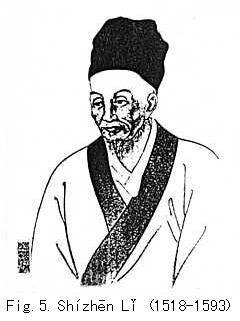
The oldest authentic record of a Chinese bipaliid species was found in Ch'éng-Shíh T'uan's ms., entitled “Yu-Yang Tsa-Tsu” (Yûyô-Zasso in Japanese pronunciation), is a collection of tales of a wizard including essays (cf. Kawakatsu & Lue, 1984: 14, bottom; Fig. 2 top-left). This Chinese literary man living in mid-eastern China in the middle of the 9th Century, wrote a note on “T'u-K'u” or “To-K'u” (Doko in Japanese pronunciation). In short, the animal he observed had a flat, chisel-shaped head, body approximately 60 cm in length, with brownish color of the dorsal body, with black and yellowish folds (or stripes). A verbatim English translation of his description is given in a paper by Lue & Kawakatsu (1986:317-318).
In 1590 (or 1593?), a monumental series of 52 vols. wood-block books of Materia Medica was published by a herbalist, Shin-Chên Li (=Shízhen Li, 1518-1593; Fig. 1): “P'ên-Ts'ao Kang-Mu” (=Honzô-Kômoku in Japanese pronunciation). A description of the “T'i'en-Shê” (=Tenja in Japanese pronunciation; it means ‘snake in the sky’), presumably a bipaliid land planarian, is included in vol. 3. Read (1934: 348; see Fig. 2 left-bottom) presented a short, free English translation of that article as the “Chekiang Shake”; he considered the animal to be a Bipalium sp. The literal English translation was given by Lue & Kawakatsu (1986: 318).
After a set of original copies of this wood-block book was introduced into Japan in 1607, several wood-block reprints and/or various kinds of similar works were published in Japan. Descriptions of “Tenja”, or “Doko”, in these Japanese Materia Medica undoubtedly indicate Bipalium species. Some of these descriptions are faithful reproductions of the Chinese book. Similar reproductions mentioned about Japanese bipaliid species with woodcut figures were also published. In Fig. 2, the three species described above are shown (top-right and middle: “Wakan-Sansai-Zue”, 1713;middle-right:Kinmô-Zui, 1666).
English translations of “Doko” from these wood-block books were given in a paper by Lue & Kawakatsu (1986: 318-319). (See also Kawakatsu, 1969; Kawakatsu & Lue, 1984;Kawakatsu, Tamura & Lue, 1984.) Additionally, photographs and figures of the bipaliid sections in various versions of Materia Medica will be found in papers cited above.
In general, external features of bipaliid species (probably Bipalium spp.) observed in eastern (and mid-central) areas of China in that pre-scientific age are summarized as follows:
“The animal has a flat, chisel-shaped [semilunar] head and measures 60 to 120 cm in length. The coloration is yellowish red with black (and yellow) stripes on the dorsal surface of the body. It lives in moist and shaded places and appears when rains have ceased.”
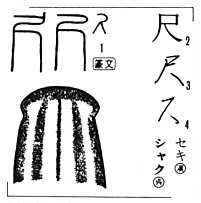 |
Fig. 6. Change of the style of a hieroglyphic Chinese character "chi" (ca. 30.3cm). 1, 3 old letters used in China (ca. BC 250; 2-4, present-day letters using both in China and Japan (2, a printed style; 3, a cursive style; 4, a very cursive style). Reproduction of the head of Bipalium cantori (Wright, 1860) (after Katô, 1950). |
In Japanese Materia Medica, the descriptions of “Doko” are slightly different in each version. This may be due to additions and/or omissions for the descriptions in their Chinese books. Sometimes, the new findings observed by Japanese naturalists were included in their old wood-block books. For example, Ryôan Terajima (? - ?), a herbalist living in Ôsaka in Central Japan, wrote in his book “Wakan-Sansai-Zue (1713)” as follows:
“Doko” or “Toku”. “The animal has the shape of a Japanese belt in general appearance and is without legs. It measures up to 12 to 15 cm in length; a large specimen attains about 30 cm. The body is flattish in shape as a leaf of leek. There are yellow and black folds [stripes] on the dorsal surface. The animal has a head shaped like a Japanese [hemispherical] forceps. The creeping trace [sole] of a living animal appears [ventrally] as a white line. It lives in moist places. If the animal is touched, fission may occur. The animal usually chases an earthworm, and the captured worm becomes water.... (etc.)”. (Cf. Lue & Kawakatsu, 1986:319.)
Some ecological notes found in Terajima's book are undoubtedly based upon his observations of Japanese bipaliid species because these descriptions are not found in Chinese versions of Materia Medica. It is an interesting fact that Terajima's (1713) animal is smaller in size than that of the Chinese animal described in Li's (1593) book. It is highly probable that they may be different species. There is a possibility that the animals observed by Terajima (op. cit.) were B. multilineatum.
Note. For the indication of the length of animals in Chinese and Japanese Materia Medica, Chinese letters “chi” or “che” (=shaku in Japanese pronunciation) and “cùn” (=sun in Japanese pronunciation) are used as a linear measure. The former is essentially a hieroglyphic character showing a sideview of a walking man, i.e., a step (Fig. 6, 1-4)(ca. 30.3 cm). This length is nearly the same as ‘foot’(originated from an Old English word ‘fot’)(ca. 30.5 cm). “Cùn” (sun) is one-tenth of (shaku)(ca. 3.03 cm).
Cantor, in 1842, reported species of “Hirudo?” from the Chou-Shan Islands, in mid-eastern China. One of his species was described by Wright (1860) as “Dunlopea Grayia”; it is now known as Bipalium grayi (Wright, 1860). Judging from a woodcut (Wright, op. cit.; 55, bottom), this brownish colored species has a body length of approximately 10 cm with 2 or 3 dorsal stripes.
Wright (1860) also described “Dunlopea Cantoria” from the Island of Nin-P'o, Chou-Shan, in China; he gave a woodcut of the anterior part of the body (p. 56, middle-right). This species is now known as Bipalium cantori (Wright, 1860). The species has 5 longitudinal stripes on the dorsal side of the body. Later, Kaburaki (1922b) and Katô (1950) gave redescriptions of B. cantori from mid-eastern China. It is a dark to blackish brown species (70-165 mm long in the preserved condition); the blackish dorsal stripes consist of a fine middorsal one and two pairs of wide, lateral and marginal stripes (Fig. 6, bottom-left).
Stimpson (1861) noted a species that he discovered in 1854 in the garden of Sir J. Browring in Hong-Kong (Browring's ‘ground-leech’; the sample was lost). According to his description, without naming the animal (Stimpson, 1861a;134-135; 1861b:231-232), this large-sized species (ca. 60 cm or more in length and 3 mm in width) has a lunate head; a grayish color with 2 or 3 longitudinal, black stripes dorsally. (For the entire citation, see Kawakatsu, Makino & Shirasawa, 1982: 258). Later, Diesing (1862) named the above-mentioned species as “Bipalium Stimpsoni”. Although the name of this species was mentioned by several authors, its genital anatomy is not known. Therefore, Bipalium stimpsoni Diesing, 1862, is a species inquirenda (cf. Ogren & Kawakatsu, 1987: 103).
Recently, a Chinese book entitled “Pictoric Keys to Soil Animals of China” was published; its section “Plathelminthes” was written by Sun & Wu (1998: 43-44, 432). They gave two pen-and-ink drawings of bipaliid species (for reproduction, see Fig. 7). The localities and sizes of these animals are not given in their article. Judging from the looped and coiled condition of animals diagramed, they may be flat and very long (probably, 35 to 45 cm or more in length if calculated from the ratio of the width to the length of the body). Moreover, the shape of the head and stripes on both dorsal and ventral sides of the body can be seen in these figures. In speculation, it is estimated that the left figure may represent B. nobile (without an enlargement of the middorsal stripe at the region of the pharynx-copulatory apparatus; with two ventral stripes). The right figure may show B. kewense (with a patch on each side of the “neck”; without an extension of the middorsal stripe onto the head; with an enlargement of the middorsal stripe at the pharynx-copulatory apparatus region; with broad lateral stripes; with two ventral stripes). (See both an open and solid arrows added in Fig. 7, right.)
Additionally, B. kewense has been recorded from Hong Kong in China (cf. Ogren, Kawakatsu & Froehlich, 1997; Winsor, 1983).
In Taiwan, Kaburaki (1922a) reported the occurrence of Stimpson's (1857) species in Taipei under the name of “Placocephalus virgatus”. A painted color sketch of the prepharyngeal region of his non-sexual specimen is included in his paper (pl. 1, fig. 18; this sketch, taken from the shrunken preserved specimen, is not reliable in appearance). Winsor (1983) pointed out that Kaburaki's (op. cit.) record of “Pl. virgatus” is a misidentification of B. kewense.
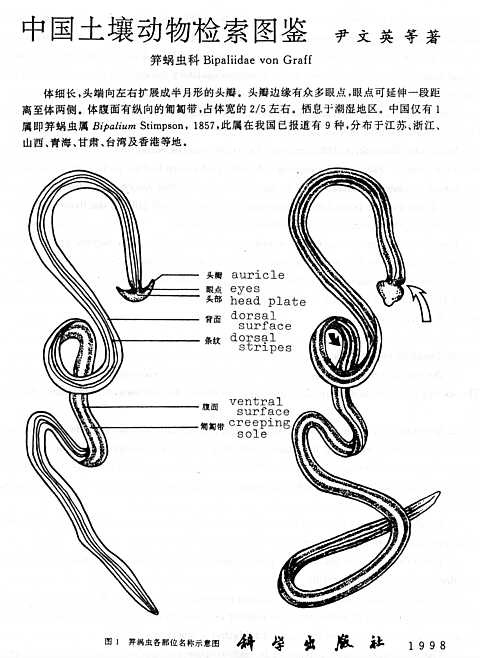 |
Fig. 7. Reproduction of sketch figures of two Chinese bipaliid species from the article by Sum & Wu (1998: 43, fig. 1). English terms were given for Chinese terms; slightly retouched. For the other explanations, see the text. |
Kawakatsu has many taxonomic samples of bipaliid species from various areas of Taiwan (preserved specimens and serial sections), that are not yet identified. Several of these unknown species have dorsal longitudinal stripes and with or without ventral stripes (cf. Kawakatsu, Lue, Takai, Hori, Muto & Osawa, 1985:120-122, fig. 8; 1986:70-71, fig. 6). Their taxonomic descriptions will be done in future.
1. The natural range of Bipalium nobile is considered to be mid-central (and southern?) China. The species may have been introduced into Japan (probably the vicinities of Tôkyô) after World War II.
2. According to Winsor (1983), the natural range of Bipalium kewense extends from Vietnam to Kampuchea possibly extending to Malaysia. We fully agree with his opinion. In the Far East, its dispersal may have been accelerated after World War II. It is suggested that this species was first introduced into Okinawa and/or Tôkyô in Japan. The Ogasawara population of B. kewense may be from Okinawa.
3. Bipalium multilineatum may have originated in Japan before arrival of other species and is considered a native to Central Japan.
4. These three bipaliid species may have expanded their domains as the result of commercial distribution of potted garden plants.
5. The speed of dispersal of B. nobile in Japan is more rapid than that of B. kewense. This could be due to the large size of B. nobile, the large number of fission pieces during fragmentation, as well as the great regenerative power of fragments. Cf. Makino & Shirasawa (1987).
6. The distribution range in Japan of B. multilineatum has gradually expanded. It is dispersed more slowly than B. nobile and B. kewense.
Bipalium multilineatum is reported from the Kantô and the Kinki Regions in Honshû and the vicinities of Nagasaki City in Kyûshû, Japan (choromosome no.: 2x=10). No sexually mature specimen is obtained. Thus, the correct taxonomic position of this species based upon the genital anatomy is not yet determined. The original place of this species is also an open question.
See Sections on B. multilineatum in this web article: a paragraph and a Note (in ‘Conclusions for species of Japan’) and Concluding Remarks 3. See also a Footnote** (in ‘Prologue’), a Note (in ‘ “T'u-K'u” in Chinese Materia Medica seems to be Bipalium nobile and B. kewense ’) and a Note (in the Section ‘Taxonomy of the land planarians (families and subfamilies)’ ) of the following web article: Bipaliid Land Planarians Recorded in Chinese and Japanese Materia Medica (by Sasaki, G.-Y., 2001) http://www2u.biglobe.ne.jp/~gen-yu/kougai_e.html